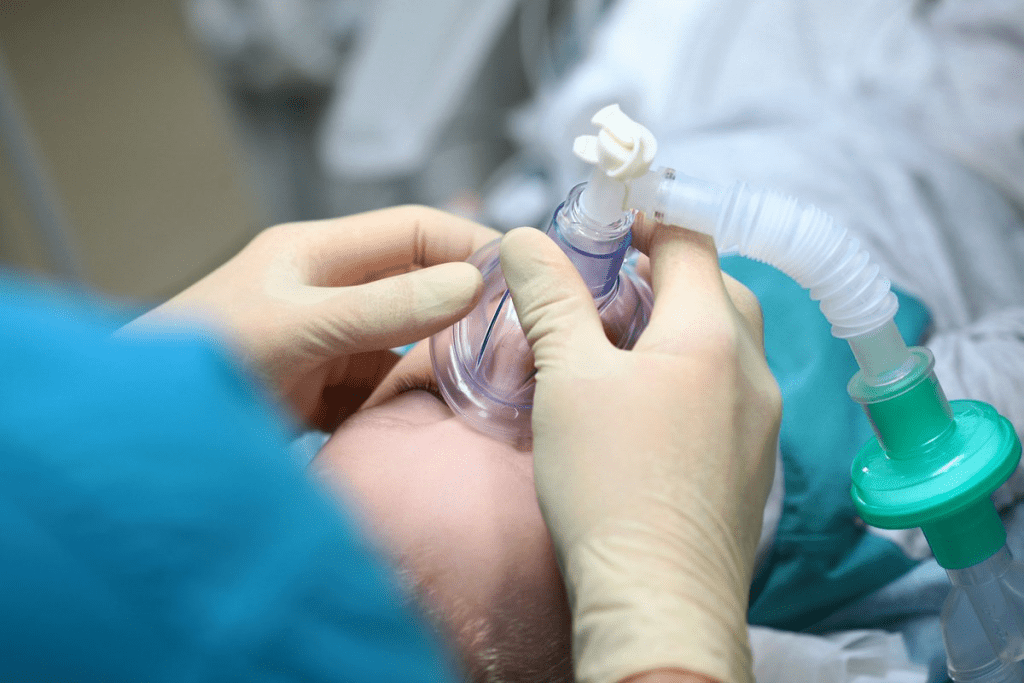Last Updated on November 14, 2025 by
Anesthesia awareness is when patients are awake during surgery but can’t move or speak. It’s a rare but serious side effect of anaesthesia general. We work hard to lower the risks of surgery, and this is a key area we focus on.
This condition happens in about 0.1% to 0.2% of surgeries. It’s a big worry that makes us think carefully about anesthesiology risks. We use the newest research to keep patients safe.

We’re dedicated to top-notch care and understanding anesthesia awareness risks. By working together and keeping up with new anesthesiology research, we aim to lower this complication.
Anesthesia awareness is rare but tough for patients and doctors. We must tackle this issue head-on. We offer support to those who have been through it.
Anesthetic awareness, or intraoperative awareness, happens when a patient is awake during surgery. They might hear sounds, feel pain, or dream. It’s a big deal because it can really upset the patient.
People who go through this might feel anything from a little discomfort to a lot of pain. Knowing what anesthesia feels like helps us find better ways to prevent and treat it.

Anesthesia awareness can deeply affect a person’s mind. It can cause anxiety, depression, and even PTSD. We need to be kind and understanding to those who have gone through this.
We create a caring space to help patients deal with what happened. We listen to their stories, offer counselling, and sometimes, we provide psychological help. This helps lessen the long-term effects.
Our goal is to understand and address anesthesia awareness. We focus on our patients’ well-being. This way, we hope to reduce the risk of anesthesia awareness and its mental effects.
Medical professionals must understand anesthesia awareness to ensure patient safety. This condition, where patients are awake during surgery, worries both patients and doctors.
Anesthesia awareness happens in 0.1% to 0.2% of cases. Though rare, it’s a big concern that needs focus and management. Knowing these numbers helps us find ways to improve anesthesia care.
A 2024 study found an incidence of 0.3%. This shows we need to keep researching and improving anesthesia care. It also means we might be underestimating how common anesthesia awareness is.
Delayed memory is a big challenge in tracking anesthesia awareness. Patients might not remember right away. Sometimes, they recall weeks or months later. This makes it hard to report and document.
It’s key to understand the incidence of anesthesia awareness and its reporting issues. By keeping up with research and following best practices, we can reduce this complication. This will help improve patient outcomes.
It’s key to know the high-risk scenarios and patient groups to avoid anesthesia awareness. Some clinical situations and patient traits make this risk higher. So, anesthesiologists must stay alert.
Trauma and emergency surgeries are risky for anesthesia awareness. The hurry of these surgeries might mean that anesthesiologists use less anesthetic. This could raise the chance of awareness. Also, patients in emergency surgeries often have unstable blood flow, making it hard to keep them fully anesthetized.
Cardiac surgeries and other risky procedures also face a higher risk of anesthesia awareness. These surgeries need special care with anesthesia to keep the heart stable. The surgery’s complexity requires a fine balance between keeping the patient asleep and keeping their blood flow steady.
Some patient factors can up the risk of anesthesia awareness. These include having had anesthesia awareness before, substance abuse, and genetic factors that might change how anesthetics work. Knowing these helps anesthesiologists tailor care for each patient, which could lower awareness risk.
By spotting these high-risk situations and patient groups, we can act early to lower anesthesia awareness risk. This makes surgery safer for our patients.
The choice of anesthetic technique is key in preventing anesthesia awareness during surgery. Healthcare providers must know the different methods and their effects on patients.
Total intravenous anesthesia (TIVA) increases the risk of awareness. It involves giving anesthetics through an IV line. TIVA has benefits but requires careful monitoring to avoid awareness.
With TIVA, we must watch the dosage and rate closely to lower the risk of conscious anesthesia. It needs a skilled and attentive anesthesia team.
Balanced anesthesia uses various agents and techniques for better results. It allows for a customized anesthesia plan, potentially lowering awareness risk. By mixing inhalational agents, intravenous anesthetics, and other meds, we tailor anesthesia to each patient.
Monitoring anesthesia depth is vital, no matter the technique. Advanced tools help us check consciousness levels and adjust anesthesia plans. We use these tools to keep patients unaware during surgery.
Knowing how do they wake you up from anesthesia is important for patient care. The process involves careful planning and monitoring for a smooth recovery. By combining the right anesthetic techniques and tools, we reduce complications and ensure the best outcomes.
We can stop anesthesia awareness by using teams, new tech, and checklists. This mix is key to lowering risks with general anesthesia.
A team effort is essential to avoid anesthesia awareness. Working together, anesthesiologists, surgeons, and nurses make sure patient care is top-notch. This teamwork helps spot and fix risks early on.
Good communication is vital in teamwork. Clear communication among team members stops mistakes and keeps safety first.
New monitoring tools are key in spotting and stopping anesthesia awareness. Tools like bispectral index (BIS) and entropy monitoring check anesthesia levels. This helps keep patients safe and reduces awareness risks.
These technologies also cut down on long-term side effects from bad anesthesia. By making sure patients are fully anesthetized, we avoid serious issues.
Using set protocols and checklists is also important. Standard checklists make sure every step is followed, cutting down on mistakes. This way, surgeries are safer for everyone.
These protocols also tackle worries about how long an anaesthetic stays in your system. They make sure anesthesia is given and watched over right.
Anesthesia awareness is a rare but serious issue with general anesthesia. We’ve talked about its occurrence, who’s at risk, and how to prevent it. Patients often ask, “do you dream under anesthesia?” But most don’t dream or wake up during surgery.
We’ve looked into the details of anesthesia awareness. This includes what it is, its importance, the latest studies, and how to stop it. Using Total Intravenous Anesthesia (TIVA) and advanced monitoring can help. It’s also key to know “how long does anesthesia stay in your body” for full care.
By weighing the risk of anesthesia awareness against the need for surgery, we aim for the best results. Our dedication to safe and effective care never wavers. We keep working to improve anesthesia care.
Anesthesia awareness is when a patient is awake during surgery. This happens when general anesthesia doesn’t work as it should. It can cause lasting emotional scars.
Anesthesia awareness happens in about 0.1-0.2% of surgeries. But, new studies say it might occur in 0.3% of cases.
Some people are more likely to experience anesthesia awareness. This includes those in emergency surgeries or with certain health conditions.
To prevent it, doctors use teams, new monitoring tools, and follow strict guidelines. These steps help lower the risk.
TIVA might increase the risk of being awake during surgery. This is because it can be harder to control.
Waking up from anesthesia varies. It depends on the anesthesia used and the patient’s health. It can take minutes to hours.
Some people dream or have vivid experiences under anesthesia. But, we don’t fully understand these experiences.
Rarely, anesthesia can cause lasting effects. These can include memory loss, cognitive problems, or chronic pain.
Anesthesia’s duration in the body varies. It depends on the type and the patient. Most anesthetics leave the body in a few hours.
Conscious anesthesia, or sedation anesthesia, lets patients stay awake during procedures. It provides pain relief and comfort without full consciousness.
Subscribe to our e-newsletter to stay informed about the latest innovations in the world of health and exclusive offers!